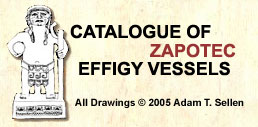| Key: EMB 26836 |
| Actual Location: Ethnographic Museum (Ethnologisches Museum), Berlin, Germany. |
| Collection: Edward Seler 1905. |
| Registration: IV Ca 26836 |
| Provenance: Xoxocotlán, Oaxaca. |
| Measurements: 53.6 x 14 cm. |
| Color: Grey clay |
| Chronology: Pitao 350 - 500 AD |
| Click to view Chronology |
| Reference: Schuler-Schömig 1970: 45, plate 35. Exhibited at the Mesoamerica Hall of the Ethnographic Museum of Berlin, Germany. |
| Comments: Effigy of Cocijo. This piece probably has a counterpart at the Royal Museum of Ontario (see ROM 1953), and an almost identical head in the Frissell Museum in Mitla (see MFR 1224). |
| Glyphs: Three dots can be seen in the headdress, but there are indications that there were originally five. The relevant glyph is missing. |
| Dating: TL by Goedicke et al. 1992, test No. 35: authentic (TL's date: A.C. 1273-1343). |
|
